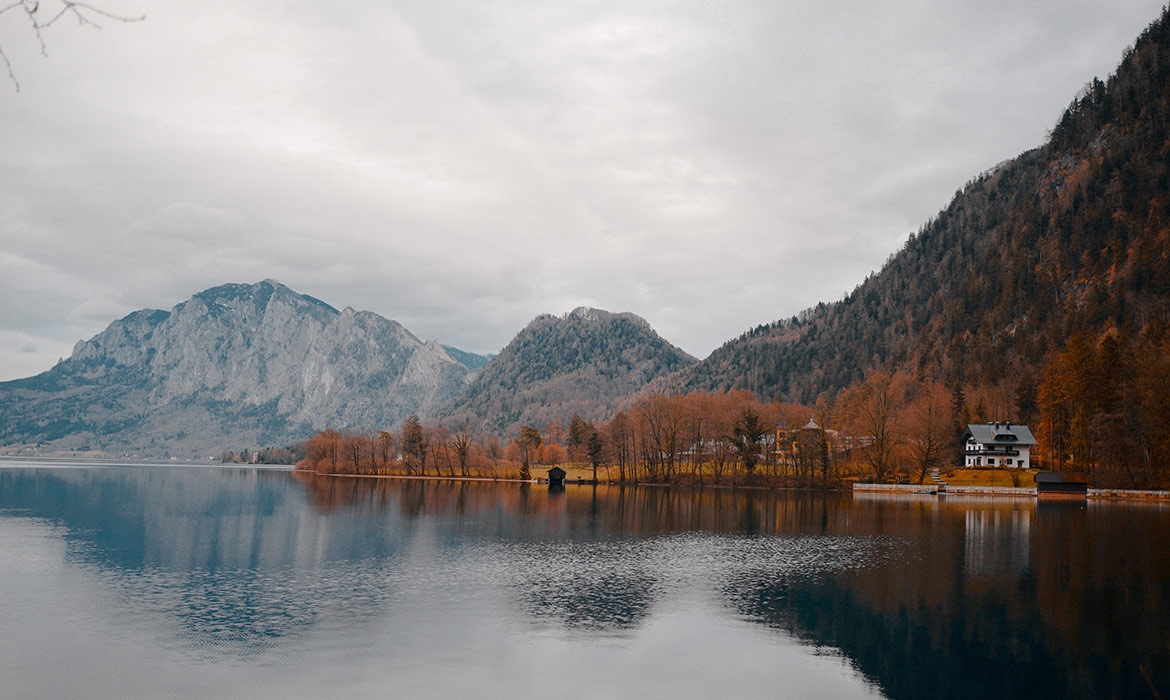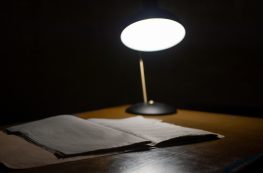The Nazis intended to build a Fourth Reich in this alpine fortress, but the Allies had other plans. Near the end of the war, these lakes became a dustbin of sorts, collecting whatever the enemy dumped into their waters—weapons, counterfeit banknotes, concentration camp lists—as they fled south from the Allied troops. The Devil’s Dustbin, locals call it.
By Melanie Dobson, author of Hidden Among the Stars
Backpacking across Europe—that’s how my husband, Jon, and I decided to celebrate our fifth wedding anniversary. We savored the old-world culture and charm as we hiked along Italy’s coast, toured medieval castles in Germany, and cruised the canals in Belgium, but we both left a bit of our hearts in an ancient Austrian town called Hallstatt.
Near the end of our monthlong trip, a ferryboat met Jon and me and our oversized packs at a train station along Hallstättersee (Lake Hallstatt), delivering us to the village on the opposite shore. Hallstatt’s wooden boathouses and storybook homes seemed to be clinging to the side of an Austrian Alp, and the moment we stepped off the ferry, we crossed through a portal of sorts, traveling back a few centuries as we walked along a cobblestone lane to the town square. The rugged, snow-capped mountains and alpine lake, the quaint village with its church steeples and waterfall that spilled into town—all of it captivated us.

Along the shore, hidden partially by trees, we could see spires of an abandoned castle, and I wanted to know its story. No one in Hallstatt could tell us who’d lived in the castle—at least, not in English—so my husband agreed to a new adventure. With a swan as our escort, we glided across the lake in an electric boat so I could study the rusty turrets, boarded windows, and old boathouse resting in the water like a felled log.
Instead of quelling my curiosity, the visit ignited the match of inspiration in my mind. Who had lived in this castle and what happened there? I began writing in my journal that night, trying to capture my rogue thoughts on paper, hoping that one day a novel would emerge from the ashes of this castle’s story.
When we returned home, I began researching more of Hallstatt’s history and discovered that this region, in all of its beauty and mystique, had been infiltrated by an enemy in 1938. This town and the surrounding Salzkammergut became a mountain retreat for Nazi officials who built mansions on the shores of its many lakes and tested submarines in the deep water. They also used salt mines in the mountains to hide “ownerless treasure,” the gold bullion and artwork they’d stolen from the Jewish people.

The Nazis intended to build a Fourth Reich in this alpine fortress, but the Allies had other plans. Near the end of the war, these lakes became a dustbin of sorts, collecting whatever the enemy dumped into their waters—weapons, counterfeit banknotes, concentration camp lists—as they fled south from the Allied troops. The Devil’s Dustbin, locals call it.
Lake Hallstatt plunges more than four hundred feet between the mountains. Because of its depth and the many hiding places in the underwater forests, caves, and shifting sands, divers continue finding World War II artifacts, almost eighty years after the war. Some still believe there’s a treasure trove buried on the bottom, but no one has reported finding any gold.
As the years passed after our trip—and access to online material grew—I was able to find out more about Schloss Grub, the medieval castle on Lake Hallstatt’s shore. One of its first owners was an eccentric salt administrator named Count Christoph Eyssel von Eysselsberg who stated in his will that his casket must journey across the lake every fifty years, from Hallstatt’s village church to his former home. During World War II, I discovered, this estate was used as a Hitler Youth camp, but my imagination had to fill in many gaps about what happened there after Austria was annexed into Nazi Germany.

Much has been written about World War II treasure since Jon and I visited Hallstatt, but a story about this castle and what happened to the heirlooms of the Austrian Jewish people continued to burn inside me until I finally put it on paper. So I built Schloss Schwansee—Castle of Swan Lake—in my mind, inspired by Eysselsberg’s story, and created a cast of historical and contemporary characters who are searching for lost treasure.
Hidden Among the Stars is a time-slip novel about an Austrian castle and treasure and fairy tales, but most of all, it’s a story about God using ordinary people across Austria to resist evil in their own extraordinary way.
 Hidden Among the Stars by Melanie Dobson
Hidden Among the Stars by Melanie Dobson
From the award-winning author of Catching the Wind, which Publishers Weekly called “unforgettable” and a “must-read,” comes another gripping time-slip novel about hidden treasure, a castle, and ordinary people who resisted evil in their own extraordinary way.
The year is 1938, and as Hitler’s troops sweep into Vienna, Austrian Max Dornbach promises to help his Jewish friends hide their most valuable possessions from the Nazis, smuggling them to his family’s summer estate near the picturesque village of Hallstatt. He enlists the help of Annika Knopf, his childhood friend and the caretaker’s daughter, who is eager to help the man she’s loved her entire life. But when Max also brings Luzia Weiss, a young Jewish woman, to hide at the castle, it complicates Annika’s feelings and puts their entire plan—even their very lives—in jeopardy. Especially when the Nazis come to scour the estate and find both Luzia and the treasure gone.
Eighty years later, Callie Randall is mostly content with her quiet life, running a bookstore with her sister and reaching out into the world through her blog. Then she finds a cryptic list in an old edition of Bambithat connects her to Annika’s story . . . and maybe to the long-buried story of a dear friend. As she digs into the past, Callie must risk venturing outside the safe world she’s built for a chance at answers, adventure, and maybe even new love.




